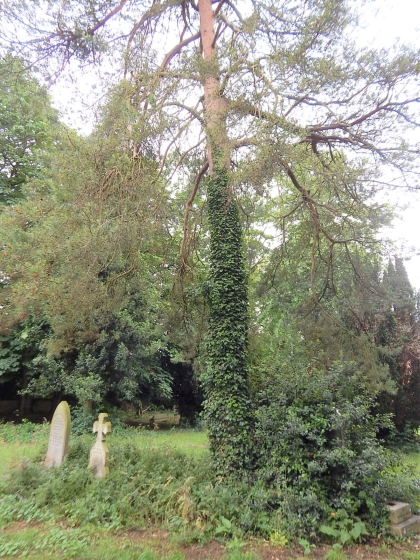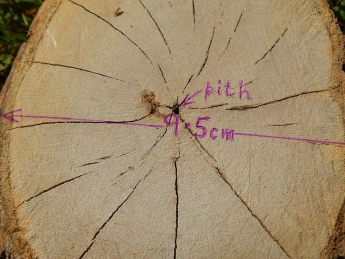A Trillion Trees
Ivy
Latin name Hedera Helix. Common Ivy, or English Ivy as it is sometimes known as, is a climbing plant that is equally at home climbing a wall or a tree. Ivy in the US is an invader species and because of its aggressive nature is rated in some states as a Class C noxious weed.
It is my conviction that the effect of ivy on trees is always negative; above the ground it causes shading and prevents air from reaching the bark of the host tree, underground the roots severely limit the tree's access to the essential resources of nutrients, moisture and space and makes it more susceptible to pests, disease and wind damage as well as causing poor foliage growth and over time ivy will reduce the growth of the branches especially the lower ones. Adjacent trees are also affected by shading and the tendency of tree ivy roots to grow outwards from the affected tree.
The coexistence of Ivy and trees is not a symbiotic one, neither is ivy truly a parasite. The ivy is, however an unwelcome burden in that it uses the structure of the tree to achieve the height necessary to reach sunlight and it then starts shading the host tree and adjacent trees of this resource and, of course, depriving the tree of nutrients, moisture and root space.
Ivy is a weight burden to the tree and it makes the tree more vulnerable to storm damage as a result of the combination of weight and increased cross sectional area. Most of the weight of the ivy is, like most living things, due to water and if it is also waterlogged by rainfall, just the water alone can weigh as much as three quarters of a ton.
With the rapid onset of cimate change and other stress factors it is increasingly important to optimise the growing environment for native trees and this includes removing ivy. Stunted and damaged trees are obviously not as effective at producing oxygen and sequestering carbon dioxide as a healthy one. Volunteer ivy pullers are needed everywhere. Forests weakened by rapidly increasing temperatures can more easily fall victim to ivy's opportunistic nature.
When ivy is not controlled in woodland, it often becomes the dominant ground cover plant, resulting in a monoculture which someone described as a "Green Desert". Ivy smothers seedlings and displaces many of the native species that are vital to a healthy woodland ecosystem.
It is imperative to remove ivy from young trees and mature trees benefit as well. Ivy will, if sufficiently well established prevent light reaching lower foliage of not only the host tree but nearby trees and the forest floor.
Ivy damaged trees can recover to some extent if the ivy is killed off, however, if the infestation started off when the tree was relatively immature and has been present for many years they usually remain misshapen and spindly, perhaps for the rest if their lives. A tree that has been "liberated" from Hedera will quite obviously have less growth in the lower branches, in extreme cases this gives the tree a kind of cauliflower appearance.
Even in the UK, where it is a native species it often grows uncontrolled and can be a serious problem. Woodland in England was, until recently almost always well managed and ivy prevented from overrunning. Deer used to be present in woodland and their grazing would help to control its growth on the forest floor. In groves where the trees are sparsely planted the ivy can receive enough light to allow it to quickly cover the forest floor and oust all other species, and then, in time, reach up to the upper branches. Ivy is naturally excluded from the main body of ancient European forests, but will invade and colonise secondary and more recent plantings.
So even in its source country it is often a problem, it should always be removed from trees such as the Larch and Ash as their foliage allow light to reach the encroaching vine, speeding its ascent.
Could some new factors be making ivy more robust and "thuggish". Climate change and newly introduced diseases are currently decimating native trees but are having less effect on ivy. Also, some of the imported ivy cultivars could be hybridising with the local variety, and there may be non-native species present in the UK as well. Most ancient woodland in the UK does not experience a major problem with ivy invasion and it tends to remain on the periphery.
In the US and countries where ivy is not a native species great care needs to be taken to prevent uncontrolled proliferation and release, it should be prevented from reaching its mature form as it's seeds can be spread by birds. Some varieties are very attractive and it is an easy ground cover solution, but planting English or Irish Ivy can result in enormous damage to local woodland and some forests may never recover. Responsible people should eradicate it wherever it appears.
Why not get together with some friends and have an "Ivy Pulling Party". You can all have some fun and see the forest becoming beautiful again. It will be quite hard work and results will not be obvious straight away, but it is such good exercise and it's beneficial for your physical and mental health.
Caution:-Ivy is toxic to humans, pets and domestic animals, and can cause dermatitis.
Killing ivy on trees.
Remember to use a good pair of gloves and wash thoroughly after working with ivy. Obviously the unrelated Poison Ivy is very much more harmful than Common Ivy, but English Ivy sap is an also irritant. Also use protective goggles, or at a pinch glasses or sunglasses. The gloves will not only protect you from the toxic sap but you will be using sharp tools and the author has some personal experience of saw scratches on bare limbs and similar minor accidents.
Immediately pulling the ivy away from the tree after the ivy has been cut off from its roots is not recommended, as the bark of the host tree could be damaged. The job of pulling off the dead ivy vines, if it is necessary, should be delayed for a year or two and left to someone who can execute the removal without damaging the tree - and other humans (ivy can be very heavy).
A popular approach is to cut the vines in a ring around the tree, usually around chest height and then again at the root level, or even below the soil level. The disconnected vine should be left for at least a good few months before attempting to pull then off, a couple of years is even better. When some time has elapsed the vines can then be very gently pulled off, great care being taken to ensure that the bark is not damaged. Also be careful about not penetrating the bark when cutting the vines, gently lifting the vine away from the tree with a screwdriver can allow a pruning saw or pruning shears to be used. More at this link- https://www.gardeningknowhow.com/ornamental/groundcover/english-ivy/english-ivy-tree-damage.htm
Caution:- English Ivy is toxic to humans, pets and domestic animals, and can cause dermatitis. Wear gloves and cover exposed skin, wear a mask if raising dust when cutting or removing it.

